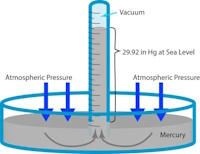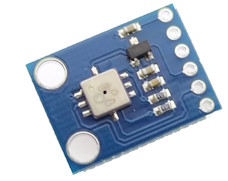Air Pressure
Air pressure is the weight of air above a point on the earth's surface and is caused in part by the earth's gravitational pull. Other factors which affect the weight of the air include
 temperature of the air, the combination of the different gasses and the quantity of water in the air.
temperature of the air, the combination of the different gasses and the quantity of water in the air.Another important factor in calculating air pressure is the height above the surface of the earth. Normally as you go higher the air pressure drops. However there's a phenomenon known as a temperature inversion where the temperature of the air increases with height instead of the normal decrease. This effect can change the measured air pressure with height.
Sea Level
The mean sea-level pressure (MSLP) is the atmospheric pressure at mean sea level. This is the atmospheric pressure normally given in weather reports on radio, television, and newspapers or on the Internet or, in the case of aviation, metar reports.
The altimeter setting in aviation is an atmospheric pressure adjustment.to take into account of differing air pressures. This is crucial for aircraft as they need accurate height readings.
Absolute
Absolute pressure is measured relative to a full vacuum. In contrast, the pressure that is measured against atmospheric pressure which is also known as barometric pressure is called gauge pressure. A full vacuum has an absolute pressure reading of 0.
Measuring Equipment
Almost all measurements are on guage pressure rather than absolute pressure. The device used to measure such air pressure is called a barometer. The original barometer, based on a tube of mercury was invented by the Italian physicist Evangelista Torricelli a friend and student of Galileo in 1643.
The aneroid barometer comprises a small capsule with the air removed. As the atmospheric pressure changes the surface of the capsule moves and a set of levers or gears translates that movement into a rotary action and moves
 a lever on a dial.
a lever on a dial.Modern electronic weather stations use a silicon chip with a pressure sensitive element. This converts the air pressure into a voltage, this voltage is related to the air pressure and as that changes so does the voltage.
This voltage is converted to a digital signal which can be logged by a computer or weather station console. Almost all electronic sensors also include a temperature sensor, or a thermometer, which too is converted to a digital signal for display or logging.
The data on this site is for information only as accuracy cannot be guaranteed.
It is not to be used where life or limb may be compromised.
Weather Warnings
It is not to be used where life or limb may be compromised.
Weather Warnings